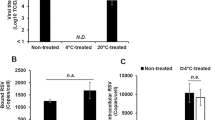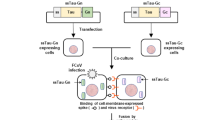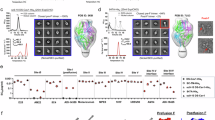Abstract
Human KC cells1 and rat XC cells2 transformed by Rous sarcoma virus (RSV) fuse to form multinucleate syncytia in the presence of several retroviruses3–11, although neither cell line itself produces virus. XC cells form syncytia on co-cultivation with cells producing murine leukaemia virus (MuLV)3 and with purified MuLV4. This altered cytopathic property is readily quantified and is a useful assay both for titrating MuLV and for detecting cells producing these viruses3,5,6. Fusion occurs from without and does not require viral replication7. We recently described the fu-1 cell line of developmentally defective rat myoblasts, which can also undergo synctia formation either by co-cultivation with cells infected with Moloney MuLV (MoMuLV) or on infection with intact or UV-inactivated MoMuLV12. On chronic infection with MoMuLV, fu-1 cells become refractive to syncytia formation12; this is also true of XC and KC cells infected with their appropriate respective viruses9,11,13. However, in contrast with XC and KC cells, fu-1 cells do release an endogenous retrovirus14,15. Whereas XC, KC and fu-1 cells are transformed and can undergo virus-induced fusion, neither 118 MG cells10 nor L8 myoblasts12 (the non-transformed parents of KC and fu-1 cells, respectively), form these virus-induced syncytia. This suggests that the capacity of cells to undergo retrovirus-induced fusion rests with their transformed status. We report here that Rat-1 cells, transformed with the temperature-sensitive transformation mutant RSV-tsLA29 (ref. 16), only form syncytia in the presence of MoMuLV when these cells are preincubaated at 35 °C, the temperature permissive for transformation, and not at 40 °C, the non-permissive temperature. Rat-1 cells transformed with wild-type avian sarcoma virus form MoMuLV-induced syncytia at both temperatures. Thus, virus-induced transformation promotes changes in these cells that render them competent to undergo subsequent virus-induced fusion.
Similar content being viewed by others
Article PDF
References
Ponten, J. & MacIntyre, F. Acta path. microbiol. scand. 74, 465–486 (1968).
Svoboda, J. Nature 186, 980–981 (1960).
Klement, V. et al. Proc. natn. Acad. Sci. U.S.A. 63, 753–758 (1969).
Johnson, G. S., Friedman, R. M. & Pastan, I. J. Virol. 7, 653–758 (1971).
Rowe, W. P., Pugh, W. E. & Hartley, J. W. Virology 42, 1136–1139 (1970).
Rangan, S. R. S., Ueberhorst, P. J. & Wong, M. C. Proc. Soc. exp. Biol. Med. 142, 1077–1082 (1973).
Ogura, H. Med. Microbiol. Immun. 162, 175–181 (1976).
Rand, K. H. & Long, C. W. Nature new Biol. 240, 187–190 (1972).
Ahmed, M. el al. Int. J. Cancer 16, 747–755 (1975).
Rand, K. H. & Long, C. W. J. gen. Virol. 21, 523–532 (1973).
Ogura, H. & Oda, T. Acta med. okayama 31, 243–247 (1977).
Wong, P. K. Y., Yuen, P. H. & Kaufman, S. J. J. Virol. 21, 319–327 (1977); 23, 768–775 (1977).
Chan, J. C. et al. Cancer Res. 34, 468–473 (1974).
Kaufman, S. J. & Parks, C. M. Proc. natn. Acad. Sci. U.S.A. 74, 3888–3892 (1977).
Kaufman, S. J. et al. Expl Cell Res. 125, 333–349 (1980).
Wyke, J. A. & Linial, M. Virology 53, 152–161 (1973).
Mishra, N. K. & Ryan, W. L. Int. J. Cancer 11, 123–130 (1973).
Prasad, I., Zouzias, D. & Basilico, C. J. Virol. 18, 436–444 (1976).
Quade, K. Virology 98, 461–465 (1979).
Author information
Authors and Affiliations
Rights and permissions
About this article
Cite this article
Kaufman, S., Ehrbar, D. Transformation of rat fibroblasts and formation of virus-induced syncytia. Nature 285, 484–485 (1980). https://doi.org/10.1038/285484a0
Received:
Accepted:
Issue date:
DOI: https://doi.org/10.1038/285484a0



